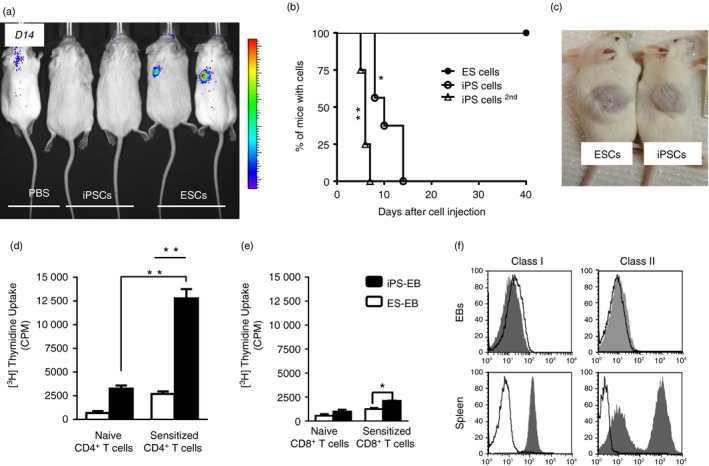Figure 1.

Induced pluripotent stem cells (iPSCs) are rejected by CD4+ T cells. (a) To determine whether iPSCs are rejected in syngeneic mice, luciferase‐expressing 129x1/SvJ iPS or embryonic stem cells (ESCs) were injected into 129x1/SvJ mice, n = 6. Mice were imaged regularly to determine the engraftment of the cells. iPSCs could not be detected after 14 days. (b) ESCs ( ) were not rejected in syngeneic mice over the 40 days of observation. In contrast iPSCs (
) were not rejected in syngeneic mice over the 40 days of observation. In contrast iPSCs ( ) were rejected after a mean of 12 days. Furthermore, mice challenged for a second time with iPSCs (
) were rejected after a mean of 12 days. Furthermore, mice challenged for a second time with iPSCs ( ) rejected those iPSCs within 5–6 days. For statistical analysis, the Log rank test was used. *P < 0·05, **P < 0·01. (c) To prove that both iPSCs and ESCs were pluripotent, the teratoma assay was performed in NOD‐SCID mice. In both cases, large teratomas developed. This is a representative result for the 129SvJ cells. (d) To determine the mechanism of iPSC rejection, splenocytes of mice that had rejected iPSCs were collected and CD4+ and CD8+ cells were sorted. The cells were exposed to iPS‐embryoid body (EB) cells in a proliferation assay. iPSCs, but not ESCs, stimulated CD4+ T cells derived from animals that had rejected iPSCs. In contrast, CD8+ T cells minimally proliferated to stimulation by iPS‐EB cells (e). Bothe CD4+ and CD8+ T cells from naive animals proliferated minimally. iPS‐EB cells induce T‐cell stimulation much more than ES‐EBs. These experiments were performed in triplicates in three mice and repeated twice. **P < 0·01 and *P < 0·05. (f) iPSCs are pluripotent and iPS‐EB cells poorly express MHC I and MHC II molecules. iPS‐EB cells do not express MHC antigens. EBs were harvested on day 7 and the cells were used to measure MHC class I and class II expression. 129x1/SvJ splenocytes were used as controls. EB cells hardly express any class I or class II antigens. Open histograms indicate class I or class II positive population and filled histograms indicate isotype control staining. [Colour figure can be viewed at wileyonlinelibrary.com]
) rejected those iPSCs within 5–6 days. For statistical analysis, the Log rank test was used. *P < 0·05, **P < 0·01. (c) To prove that both iPSCs and ESCs were pluripotent, the teratoma assay was performed in NOD‐SCID mice. In both cases, large teratomas developed. This is a representative result for the 129SvJ cells. (d) To determine the mechanism of iPSC rejection, splenocytes of mice that had rejected iPSCs were collected and CD4+ and CD8+ cells were sorted. The cells were exposed to iPS‐embryoid body (EB) cells in a proliferation assay. iPSCs, but not ESCs, stimulated CD4+ T cells derived from animals that had rejected iPSCs. In contrast, CD8+ T cells minimally proliferated to stimulation by iPS‐EB cells (e). Bothe CD4+ and CD8+ T cells from naive animals proliferated minimally. iPS‐EB cells induce T‐cell stimulation much more than ES‐EBs. These experiments were performed in triplicates in three mice and repeated twice. **P < 0·01 and *P < 0·05. (f) iPSCs are pluripotent and iPS‐EB cells poorly express MHC I and MHC II molecules. iPS‐EB cells do not express MHC antigens. EBs were harvested on day 7 and the cells were used to measure MHC class I and class II expression. 129x1/SvJ splenocytes were used as controls. EB cells hardly express any class I or class II antigens. Open histograms indicate class I or class II positive population and filled histograms indicate isotype control staining. [Colour figure can be viewed at wileyonlinelibrary.com]
